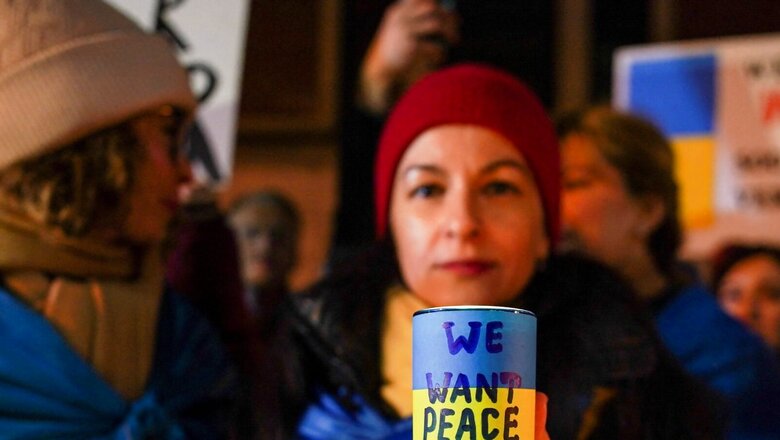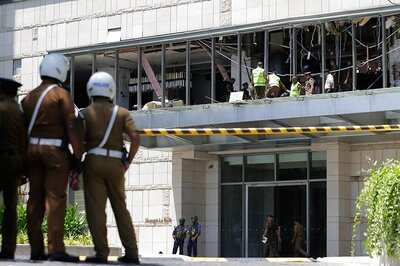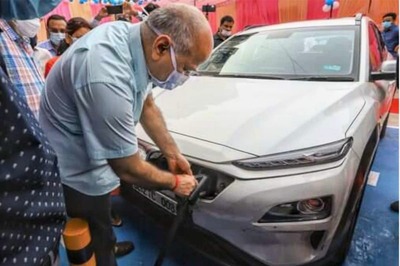
views
Since the launch of Russia’s ‘special military operation’ nearly a year ago, on 24 February 2022, both countries have suffered considerable casualties, along with thousands of tanks and other military equipment lost. Ukraine’s economy has shrunk by roughly 30 percent and over 30 percent of its population has been displaced. Its infrastructure is wrecked and almost 40 percent of its electricity-generating capacity has been damaged. However, neither side seems to be willing to compromise or even consider a cease-fire and Ukraine’s Western supporters are now busy trying to arm Ukraine with the most sophisticated weapon systems that require an extremely high degree of skill to operate.
Myriad lessons stand out covering various aspects of war and there are lessons at the tactical, operational and strategic levels. The war has also shattered many illusions that existed, particularly the one that in an inter-connected world, globalisation will act as the protective shield. The reality of war is still present, the unthinkable is possible and this has laid bare the undeniable risks and prohibitive costs of war.
No Plan Survives First Contact With the Enemy
German General James von Moltke once said that “no plan survives first contact with the enemy.” It is now obvious that Russian President Vladimir Putin may have erred when he assumed Ukraine could not mount serious resistance. He miscalculated Russia’s military prowess, Ukraine’s tenacity, and Western Europe’s ability to back Ukraine. The United States (US) and North Atlantic Treaty Organisation (NATO) also miscalculated; they discounted the possibility of war for years, exaggerated the potency of economic sanctions, and underestimated the depth of Russian opposition to Western efforts to bring Ukraine into their orbit.
The fog of war obscures vision. The first example is the most obvious: the assumption that a Russian attack on Ukraine would result in Moscow’s military victory and a change of regime. Even after Russia’s defeat in the battle of Kyiv, it took months for policymakers and analysts to internalise Russia’s initial failures. Next is the recurring prediction of a stalemate between Ukrainian and Russian troops, dug in their positions, and with both sides unable to achieve significant forward movement. Though this has been refuted by Ukrainian counteroffensives, it would be another fallacy to assume that Ukrainian counteroffensives will remain successful just because they have been in the past. War is more likely to produce surprises instead of continuities.
Full-scale warfare is still much less predictable than we may have assumed from our metrics, algorithms, war games and simulations. The role of morale, leadership, initiative, training, discipline, resolve, courage, determination and dedication are intangibles that will continue to play a crucial role in battlefields.
War is no longer ‘Short and Swift’
The Gulf War led to thinking of war characterised by ‘shock and awe.’ This tendency wasn’t surprising, given that the initial military phase of the war was short and one-sided. But the wars in Iraq and Afghanistan eventually dragged on for years, because the US chose to occupy these countries and enact far-reaching political and social reforms, the opposite of what India did in 1971 in Bangladesh, where we liberated a country. The result was a potent insurgency that could not be defeated at an acceptable cost.
Today, Ukraine is different. After one year, the conventional forces of the two countries remain locked in the grip of combat, searching for new ways to bring pressure to the other side. Neither side has been able to deliver a knockout blow. It’s more of a grinding battle of attrition with incremental gains.
Russia still remains a major power, with a large military-industrial base and substantial reserves of military equipment. Its leaders see the war as an existential conflict that Russia must win. The performance of its Armed Forces has improved since the beginning of the war and its missile and drone attacks on Ukrainian cities and infrastructure have done considerable damage. Outside support may enable Ukraine to hold the line and make limited gains but ousting Russia from all the territory it now controls may be impossible, no matter how much aid is sent. There is also the continued possibility of escalation including the use of a nuclear weapon, a danger, though being dismissed, cannot be ruled out in its entirety.
Alliances Matter But You Fight Alone
The Ukraine War demonstrates that countries in the international system unite to oppose overt acts of aggression. Believing that Ukraine would fall quickly, Russia appears to have assumed that NATO would not respond as vigorously as it did. As a result, Russia is waging a war against a country backed by a coalition with a much larger combined GDP that produces the world’s most sophisticated weaponry. Outside support does not ensure a Ukrainian victory, but it has turned what Putin assumed would be a cakewalk into a protracted conflict.
Acts of aggression are likely to lead other states to combine against the aggressor. In an unprecedented visit to Ukraine this week, US President Joe Biden stated, “Putin thought Ukraine was weak and the West was divided. He thought he could outlast us. One year later, the evidence is right here in this room. We stand together.” However, while they may provide the defender with various means, the truth remains that ‘you fight alone.’
And at the same time, it’s yet more evidence of how badly the international system fails, which is the United Nations, if a permanent member of the Security Council resorts to physical aggression. This invariably renders the UN incapable of defending countries or taking any meaningful action, as any measures against a permanent member of the UNSC are vetoed by that country.
Strategic Communication is a Force Multiplier
Influence operations matter, as has been witnessed in the Indian context with the Hindenburg Report on the Adani Group. Despite the challenges it faces, the Ukrainian government successfully created and continues to implement a strategic communications plan aimed at galvanising international support, attacking Russia, and inspiring confidence in its forces and the President.
They were able to reach out to all media, identify audiences to persuade, put together data, and connect with journalists, political figures, and influencers who further spread their government’s message. Ukrainians were able to reach out to a vast network of people who further spread their campaign through their individual networks, thus building and reinforcing Ukraine’s support base.
Although Ukrainian President Volodymyr Zelenskyy is the focal point of this campaign, he’s in no way the only person who has remained in the spotlight. People feel empowered to advocate for Ukraine images that include the blue and yellow of the Ukrainian flag, sunflowers, and children holding anti-war posters. Through social media, the Ukrainian government uses firsthand accounts and video clips as evidence, which further reinforces its message. The cohesion and duration of the strategic communication campaign has set a template for what can be achieved with an influence strategy. The limitless availability of information and the inability to verify it by most people has led to strategic communication becoming a crucial and powerful tool in war.
Role of Private Sector in Cyberspace
The information revolution has been credited with changing key aspects of warfare. Network-centric operations are now established elements of military doctrine and operations. However, the Ukraine War has brought to the fore the role of the private sector, which is engaging in direct cyber combat against Russian cyber-attacks in support of Ukraine.
Private-sector firms have worked to identify and disable malware and create a much more defensible Ukrainian cyberspace. Both Microsoft and Cisco have published reports detailing defensive cyber efforts and European cybersecurity firms such as ESET have also been involved. Ukraine’s cybersecurity defence has additionally been enhanced through the use of Starlink terminals and the transfer of Ukrainian governmental functions to cyber clouds outside Ukraine. These actions foreshadow the critical role such firms will play in future conflicts.
Countries need to have appropriate planning and operational collaborative mechanisms with the private sector, to assure the effective operation of cyberspace in an armed conflict. Maintaining the functioning of information technology in wartime, particularly for critical infrastructures such as energy, food, water, transportation, and finance, is an indispensable requirement for effective military operations.
Centrality of Hard Power
Hard power derived from military capabilities, backed by economic wealth, is back. The need for real kinetic capability and the willingness to use it is essential if our enemies are to be deterred or defeated. War also remains a test of logistics and industrial capacity. We still need transport, huge amounts of ammunition, maintenance and battlefield medical care. There is no substitute for human resources, positive leadership and well-trained, disciplined soldiers.
When Russian troops moved into their assembly areas, many analysts believed the threat of severe economic sanctions would be enough to deter a Russian attack. But Russian interests in Ukraine outweighed any potential harm that might be done to the Russian economy through sanctions. While damage has been done to the Russian economy, the Ruble has strengthened and foreign reserves have increased due to high oil prices and shifting Russian markets.
NATO leaders made it clear that they would not commit troops to defend Ukraine but displayed a willingness to rapidly arm them. Unfortunately, the reality is what deters is NATO troops, not the threat of economic sanctions. Deploying troops forward will now be the norm. Battalion-sized NATO battle groups have now been deployed in eight frontline countries and the American forces in Europe have increased substantially. Troop deployments work and having a superior military might pay.
The scope of deterrence is vast and not only includes force structures and modern equipment, but needs to be backed by doctrines, training and leadership as well as a military-industrial complex. A month after the Russia-Ukraine War, General Naravane had said, “The biggest lesson is that we have to be ready to fight future wars with indigenous weapons and the steps towards Aatmanirbhar Bharat in defence should be taken more urgently.”
President Putin’s nuclear threat literally turned nuclear deterrence on its head, as he used this not to prevent war, but to facilitate an offensive. There is no doubt that nuclear weapons remain an important foundation in shaping strategies and even though President Reagan’s remarks– “a nuclear war cannot be won and must never be fought”– holds true, more countries will be driven to acquire nuclear capabilities to safeguard their interests.
War is no longer unimaginable. In the Indian context, the most significant threat is the possibility of war with China with collusivity of Pakistan. It is no longer unthinkable and has a vast scope for escalation across every domain. To avoid a crisis and conflict, both countries must have a joint strategic framework to prevent an escalation along redlines. For the medium to long term, it will require effective deterrence for China to conclude that any war would represent an unacceptable level of risk.
What will stand out from the conflict is that a major conventional war between developed nations is possible, even under the shadow of nuclear weapons, and will remain as violent as it’s always been. Nuclear deterrence, strong alliances, economic interdependence, and international prohibitions on military aggression will continue to fail to prevent war.
Possessing and effectively using hard power will remain at the core. An armed conflict will continue to remain the most extreme instrument of violent intensity and drawing the right lessons is vital for deterring and preventing a future conflict, and if necessary, fighting one.
The author is an Army veteran. The views expressed in this article are those of the author and do not represent the stand of this publication.
Read all the Latest Opinions here



















Comments
0 comment